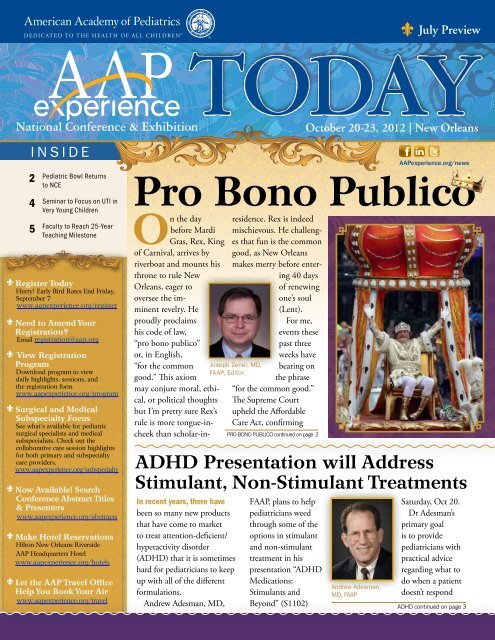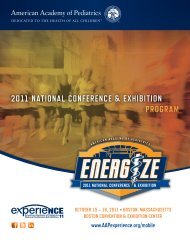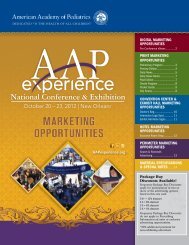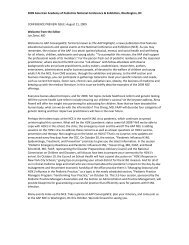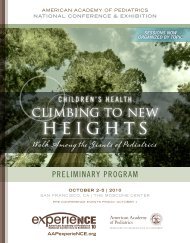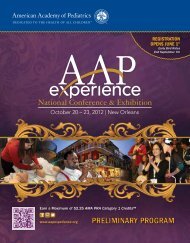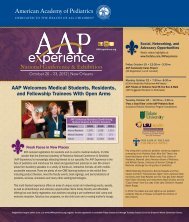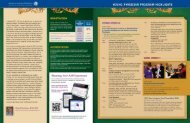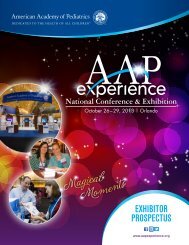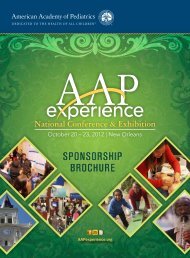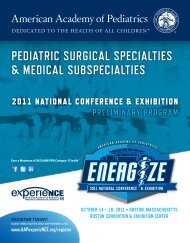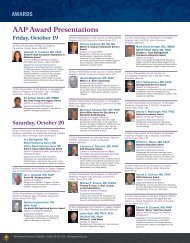Pro Bono Publico - American Academy of Pediatrics National ...
Pro Bono Publico - American Academy of Pediatrics National ...
Pro Bono Publico - American Academy of Pediatrics National ...
You also want an ePaper? Increase the reach of your titles
YUMPU automatically turns print PDFs into web optimized ePapers that Google loves.
July Preview<br />
October 20-23, 2012 | New Orleans<br />
INSIDE<br />
2<br />
4<br />
5<br />
Pediatric Bowl Returns<br />
to NCE<br />
Seminar to Focus on UTI in<br />
Very Young Children<br />
Faculty to Reach 25-Year<br />
Teaching Milestone<br />
Register Today<br />
Hurry! Early Bird Rates End Friday,<br />
September 7<br />
www.aapexperience.org/register<br />
Need to Amend Your<br />
Registration<br />
Email registration@aap.org<br />
View Registration<br />
<strong>Pro</strong>gram<br />
Download program to view<br />
daily highlights, sessions, and<br />
the registration form<br />
www.aapexperience.org/program<br />
Surgical and Medical<br />
Subspecialty Focus<br />
See what’s available for pediatric<br />
surgical specialists and medical<br />
subspecialists. Check out the<br />
collaborative care session highlights<br />
for both primary and subspecialty<br />
care providers.<br />
www.aapexperience.org/subspecialty<br />
Now Available! Search<br />
Conference Abstract Titles<br />
& Presenters<br />
www.aapexperience.org/abstracts<br />
Make Hotel Reservations<br />
Hilton New Orleans Riverside<br />
AAP Headquarters Hotel<br />
www.aapexperience.org/hotels<br />
Let the AAP Travel Office<br />
Help You Book Your Air<br />
www.aapexperience.org/travel<br />
AAPexperience.org/news<br />
<strong>Pro</strong> <strong>Bono</strong> <strong>Publico</strong><br />
n the day<br />
before Mardi<br />
Gras, Rex, King<br />
<strong>of</strong> Carnival, arrives by<br />
riverboat and mounts his<br />
throne to rule New<br />
Orleans, eager to<br />
oversee the imminent<br />
revelry. He<br />
proudly proclaims<br />
his code <strong>of</strong> law,<br />
“pro bono publico”<br />
or, in English,<br />
weeks have<br />
“for the common Joseph Zenel, MD, bearing on<br />
FAAP, Editor<br />
good.” This axiom<br />
the phrase<br />
may conjure moral, ethical,<br />
or political thoughts The Supreme Court<br />
“for the common good.”<br />
but I’m pretty sure Rex’s upheld the Affordable<br />
rule is more tongue-incheek<br />
than<br />
Care Act, confirming<br />
scholar-inresidence.<br />
Rex is indeed<br />
mischievous. He challenges<br />
that fun is the common<br />
good, as New Orleans<br />
makes merry before entering<br />
40 days<br />
<strong>of</strong> renewing<br />
one’s soul<br />
(Lent).<br />
For me,<br />
events these<br />
past three<br />
ADHD Presentation will Address<br />
Stimulant, Non-Stimulant Treatments<br />
In recent years, there have<br />
been so many new products<br />
that have come to market<br />
to treat attention-deficient/<br />
hyperactivity disorder<br />
(ADHD) that it is sometimes<br />
hard for pediatricians to keep<br />
up with all <strong>of</strong> the different<br />
formulations.<br />
Andrew Adesman, MD,<br />
PRO BONO PUBLICO continued on page 2<br />
FAAP, plans to help<br />
pediatricians weed<br />
through some <strong>of</strong> the<br />
options in stimulant<br />
and non-stimulant<br />
treatment in his<br />
presentation “ADHD<br />
Medications:<br />
Stimulants and<br />
Beyond” (S1102)<br />
Andrew Adesman,<br />
MD, FAAP<br />
Saturday, Oct 20.<br />
Dr Adesman’s<br />
primary goal<br />
is to provide<br />
pediatricians with<br />
practical advice<br />
regarding what to<br />
do when a patient<br />
doesn’t respond<br />
ADHD continued on page 3
2<br />
PRO BONO PUBLICO continued from page 1<br />
access to care for children in need.<br />
Some political pundits argue the<br />
Chief Justice voted for the common<br />
good <strong>of</strong> the court. Last week I was<br />
asked to consult on a child from a<br />
rival practice, a consult that led to<br />
multiple consults; competing practices<br />
all pitched in for the common<br />
good <strong>of</strong> the child and his family.<br />
Medicaid helped. At my institution,<br />
our very first pediatric interns are<br />
now entering their second year <strong>of</strong><br />
residency and are readily guiding the<br />
new interns and medical students,<br />
contributing to the common good<br />
<strong>of</strong> the residency program. This<br />
weekend an article in the New York<br />
Times reported a study that found<br />
that spending money for the good<br />
<strong>of</strong> others made one happier than<br />
spending money on oneself. And<br />
yesterday I received the minutes <strong>of</strong><br />
the recent AAP Combined District<br />
VI/VII meeting in which Jeff Britton,<br />
vice president <strong>of</strong> the Wisconsin<br />
Chapter, wrote that we members <strong>of</strong><br />
the AAP should “focus on<br />
the ‘pediatric soul,’ i.e.,<br />
we are here because <strong>of</strong><br />
the desire to do something<br />
good for the children.”<br />
These random yet<br />
intertwining occasions<br />
lead me<br />
Pediatric Bowl (V4069)<br />
Tuesday, October 23<br />
12:30 PM-1:30 PM<br />
Ernest N. Morial<br />
Convention Center<br />
Special Non-CME Event Free to<br />
Conference Attendees<br />
‘Pass a good time’ at the Pediatric Bowl! Play along<br />
with Louisiana’s pediatric residency programs<br />
competing for the meconium cup. Defending<br />
Champions (2003) Bonnie Desselle/Paul Cooper<br />
and their “Tchoupitoulas Tigers” from Louisiana State<br />
University will compete against Todd Washko and his<br />
“Gris-gris Green Waves” from Tulane University and<br />
newcomers Alston Dunbar and his “Cajun Krewe”<br />
from Our Lady <strong>of</strong> the Lake Children’s Hospital Baton<br />
Rouge. Who dat They’re the famed facilitators<br />
<strong>of</strong> fun! Watch moderators Lewis First, editor <strong>of</strong><br />
<strong>Pediatrics</strong>; Marshall Land, <strong>American</strong> Board <strong>of</strong><br />
<strong>Pediatrics</strong>; and William Gerson, University <strong>of</strong> Vermont<br />
College <strong>of</strong> Medicine challenge the rising stars <strong>of</strong><br />
pediatrics.<br />
playfully to the next paragraph.<br />
To me, the NCE is the theater<br />
for medical students, residents,<br />
fellows, faculty, and private practitioners<br />
to play their role and<br />
find their pediatric soul. In the<br />
mirthful midst <strong>of</strong> receptions, Kid’s<br />
Camp, Mardi Gras World family<br />
night festivities, Pediatric Bowl,<br />
and Fun Run, there are section<br />
meetings, plenaries, business luncheons,<br />
workshops, and seminars<br />
dedicated to improving and advocating<br />
care for children. Rex would<br />
approve <strong>of</strong> this forum for mixing<br />
pleasure with business.<br />
This month’s issue <strong>of</strong> AAP Today<br />
touches on ADHD treatments,<br />
UTI diagnosis and therapy, and the<br />
proper use <strong>of</strong> the ophthalmoscope.<br />
This issue also teases you with<br />
lighthearted blurbs about other<br />
NCE affairs. View the clip on the<br />
Pediatric Bowl and make sure you<br />
read the humorous yet true story <strong>of</strong><br />
an attendee in the article “Faculty<br />
Approach 25-Year Teaching Milestone<br />
at AAP Conference.”<br />
I suspect Rex also asserts,<br />
“Multa veritas tenuit in iocum”<br />
or, in English, “Many a truth<br />
is held in jest.” I always believe<br />
there is truth in humor, and one<br />
is truly happy and entertained<br />
when helping others. I like Rex,<br />
and I like his kingdom. New<br />
Orleans is just the right host city<br />
for this year’s NCE where we will<br />
meet “pro bono publico” and<br />
have fun.
3<br />
July Preview<br />
ADHD continued from page 1<br />
to an initial treatment trial <strong>of</strong> firstline<br />
medication or when the patient’s<br />
condition is more complicated.<br />
“The published response rate for<br />
stimulants when you try a single<br />
stimulant is estimated at about 70<br />
percent. So approximately 30 percent<br />
<strong>of</strong> the time, clinicians will need to try<br />
a different stimulant or try a different<br />
medication altogether. I will provide<br />
some suggestions or guidance<br />
on how to optimize medication<br />
response,” said Dr Adesman, who is<br />
Chief, Developmental & Behavioral<br />
<strong>Pediatrics</strong> at Steven & Alexandra<br />
Cohen Children’s Medical Center <strong>of</strong><br />
New York in New Hyde Park, NY.<br />
His presentation will include some<br />
discussion <strong>of</strong> alternative therapies<br />
and what place – if any – treatments<br />
like fish oil have in the treatment<br />
approach <strong>of</strong> children with ADHD<br />
as well as provide information about the<br />
effectiveness <strong>of</strong> dietary and nutritional<br />
formulations currently available.<br />
According to Dr Adesman,<br />
pediatricians should be comfortable<br />
understanding the many different<br />
medication options and some <strong>of</strong><br />
their nuanced differences in terms <strong>of</strong><br />
choosing the right medicine. That<br />
comfort should extend to developing<br />
and implementing a second line <strong>of</strong><br />
treatment when the initial treatment<br />
plan doesn’t appear to be adequate.<br />
Second-line therapy should include<br />
non-stimulants and alternative<br />
stimulant formulations.<br />
“I’ll also talk about the use <strong>of</strong> non<br />
stimulants, either as a first-line or<br />
second-line medication, or as an adjunct<br />
treatment,” he said.<br />
One <strong>of</strong> the major challenges for a<br />
pediatrician dealing with patients with<br />
ADHD involves setting appropriate<br />
family expectations in terms <strong>of</strong> benefits<br />
and side effects. The pediatrician has to<br />
be sensitive and responsive to parental<br />
concerns, requiring the pediatrician to<br />
consider the different potential areas <strong>of</strong><br />
functional improvements one hopes to<br />
see from medication and that the right<br />
outcome criteria measures medication<br />
“Setting the right expectations is<br />
always important. If parents expect<br />
too much or if they are looking<br />
for improvement in the wrong<br />
domains <strong>of</strong> function, they may be<br />
disappointed.”<br />
effectiveness. It is also important to<br />
consider possible comorbid conditions<br />
that affect the medication choice, the<br />
medication response or the child’s<br />
overall function.<br />
Dr Adesman noted that challenging<br />
issues <strong>of</strong> communication with families<br />
can be time consuming. “I’ve written<br />
that I believe it is easier for my oncology<br />
colleagues to give their patients strong<br />
chemotherapy than it is for us to give<br />
our patients a prescription for Ritalin<br />
just because there is so much hesitation<br />
and misinformation.” Resistance,<br />
anxiety, doubt and unrealistic<br />
expectations can plague the parent <strong>of</strong><br />
a newly diagnosed child. “Setting the<br />
right expectations is always important.<br />
If parents expect too much or if they are<br />
looking for improvement in the wrong<br />
domains <strong>of</strong> function, they may be<br />
disappointed,” he said.<br />
There are also possible logistical<br />
challenges for families such as availability<br />
<strong>of</strong> preferred medications and dealing<br />
with prescription plan formularies.<br />
“Choosing the best medicine is<br />
not always an option because we as<br />
pediatricians need to be mindful <strong>of</strong> what<br />
is available and affordable for families in<br />
formulary options,” he said.<br />
Dr Adesman will review the<br />
major revisions to the AAP<br />
treatment guides for ADHD,<br />
including the expansion <strong>of</strong><br />
the guidelines from preschool<br />
through adolescence. He plans to<br />
address medication management<br />
in the preschool population with<br />
attention to patient friendly<br />
formulations and issues specific to<br />
the young child.<br />
“We have to recognize that<br />
preschool kids can’t swallow pills and<br />
thus consider what that means in terms<br />
<strong>of</strong> treatment options,” he said. “I’ll<br />
also talk about some <strong>of</strong> the sensitive<br />
issues with adolescents in terms <strong>of</strong><br />
diversion, potential misuse, and some<br />
<strong>of</strong> the specific challenges <strong>of</strong> meeting<br />
the individual needs <strong>of</strong> an adolescent<br />
and college student in terms <strong>of</strong> their<br />
longer academic days and more variable<br />
schedules.”<br />
In the end, it is important that<br />
pediatricians can comfortably optimize<br />
the response <strong>of</strong> children and adolescents<br />
to medication for ADHD. “That can<br />
translate into making sure pediatricians<br />
are able to adjust the medications and<br />
pick the right formulation so that<br />
benefits are maximized and side effects<br />
are minimized.”
4<br />
Seminar to discuss urinary tract<br />
infections in the very young<br />
rinary tract infection<br />
(UTI) is a common<br />
cause <strong>of</strong> fever in infancy<br />
and is probably the most<br />
common serious childhood<br />
bacterial infection. A seminar<br />
Monday, Oct. 22, at this year’s <strong>National</strong><br />
Conference and Exhibition will focus<br />
on how pediatricians should manage a<br />
young patient with UTI.<br />
“After the First UTI: Controversies<br />
and Consensus” (S3091) will feature<br />
Ellen R. Wald, MD, FAAP, Chair <strong>of</strong> the<br />
Department <strong>of</strong> <strong>Pediatrics</strong> at the University<br />
<strong>of</strong> Wisconsin School <strong>of</strong> Medicine<br />
and Public Health, and Steven G.<br />
Docimo, MD, Vice Chair and pr<strong>of</strong>essor<br />
<strong>of</strong> Urology at the University <strong>of</strong> Pittsburgh<br />
School <strong>of</strong> Medicine.<br />
Dr Wald will discuss the new AAP<br />
guidelines for managing the initial UTI<br />
in febrile infants and children up to 24<br />
months <strong>of</strong> age. The original guidelines<br />
were published in 1999. In November<br />
2011, the AAP revised these guidelines<br />
and Dr Wald served on the Subcommittee<br />
on Urinary Tract Infection that was<br />
Don’t miss the AAP Section<br />
on Urology <strong>Pro</strong>gram’s Master<br />
Classes, a Live Robotic<br />
Surgery Pyeloplasty, and<br />
more! View urology program<br />
highlights at www2.aap.<br />
org/sections/urology/SOU_<br />
Draft_Schedule-040212.pdf<br />
View all conference sessions<br />
at www.aapexperience.org/<br />
planner.<br />
responsible for the update.<br />
She will review the guideline’s<br />
seven action statements,<br />
explain the rationale for these<br />
statements, and emphasize<br />
specific revisions.<br />
The most controversial<br />
change is Action Statement 6,<br />
which describes the criteria for performing<br />
a voiding cystourethrogram (VCUG).<br />
The original guideline called for routinely<br />
performing a VCUG after the first febrile<br />
UTI, Dr Wald said, but the updated<br />
guideline calls for postponing a VCUG<br />
until a second UTI occurs or if an ultrasound<br />
shows a worrisome abnormality.<br />
Dr Wald will begin the seminar with<br />
an overview <strong>of</strong> UTI, reviewing the<br />
pathogenesis, bacterial etiology, signs,<br />
and symptoms. She will define UTI in<br />
terms <strong>of</strong> the bacterial density required to<br />
determine whether the urine is infected<br />
and review laboratory diagnosis, including<br />
urine dipsticks and microscopy.<br />
“I think that people tend to underestimate<br />
the importance <strong>of</strong> pyuria,” she<br />
said. “Understanding that both a lot<br />
<strong>of</strong> bacteria as well an inflammatory<br />
response, which is what the pyuria<br />
indicates, are expected is an extremely<br />
important take-home message. It will<br />
allow the practitioner to know when a<br />
culture result is important as opposed<br />
to when it may be less important.”<br />
Dr Docimo will discuss management<br />
<strong>of</strong> recurring UTIs, which <strong>of</strong>ten require<br />
management <strong>of</strong> vesicoureteral reflux<br />
(VUR), along with the best ways to<br />
manage voiding dysfunction. He said<br />
voiding dysfunction is one <strong>of</strong> the most<br />
Ellen R. Wald, MD, FAAP<br />
common risk factors for recurring<br />
UTI, so a physician must<br />
assess for voiding dysfunction<br />
and, if present, manage it aggressively.<br />
All children with recurring<br />
UTIs should be evaluated for<br />
functional voiding disorders<br />
in addition to evaluation for anatomical<br />
issues, Dr Docimo said.<br />
“What we’ve learned over the years,<br />
much to our benefit and the benefit <strong>of</strong><br />
the kids that we treat, is that managing<br />
voiding dysfunction and bowel dysfunction<br />
significantly decreases the risk <strong>of</strong><br />
infection and, therefore, obviates a lot<br />
<strong>of</strong> other treatments that we otherwise<br />
might have to employ, including surgery,”<br />
he said.<br />
Non-surgical, non-invasive treatments<br />
include bowel management with longterm<br />
laxatives, timed voiding, double<br />
voiding to empty the bladder, and<br />
bi<strong>of</strong>eedback to encourage pelvic floor<br />
relaxation.<br />
When surgery is indicated, Dr<br />
Docimo said, there are new techniques<br />
that can be done on an outpatient basis<br />
or require an overnight stay. These<br />
advanced techniques maintain the traditionally<br />
high levels <strong>of</strong> effectiveness in<br />
resolving VUR and decreasing the risk<br />
<strong>of</strong> pyelonephritis.<br />
“We find that we use surgery less<br />
frequently than in the past, but when<br />
needed, it’s still a relatively common<br />
set <strong>of</strong> surgical procedures for pediatric<br />
urologists,” he said. “When needed, it’s<br />
very effective — a low-morbidity, highimpact<br />
kind <strong>of</strong> surgery.”
5<br />
July Preview<br />
Faculty Approach 25-Year Teaching<br />
Milestone at AAP Conference<br />
ost medical students<br />
are handed their direct<br />
ophthalmoscopes during<br />
the first week <strong>of</strong> their freshman year<br />
in medical school. Very little, if any,<br />
formal instruction is given on its use.<br />
Examination <strong>of</strong> the eye may be covered<br />
during one to two days <strong>of</strong> their senior<br />
year, if that. Examining techniques are<br />
sorely lacking, and most pediatricians<br />
know this,” said Steven Lichtenstein,<br />
MD, FAAO, FAAP, Associate <strong>Pro</strong>fessor<br />
<strong>of</strong> Clinical Surgery and <strong>Pediatrics</strong><br />
at the University <strong>of</strong> Illinois, College <strong>of</strong><br />
Medicine.<br />
This fall, Dr Lichtenstein and Robert<br />
D. Gross, MBA, MD, FAAP,<br />
Clinical Associate <strong>Pro</strong>fessor <strong>of</strong><br />
Ophthalmology at the University<br />
<strong>of</strong> Texas, Southwestern<br />
Medical School, will celebrate<br />
a milestone <strong>of</strong> teaching 25<br />
years for the AAP conference<br />
at their workshop “Eye Examination<br />
Skills: Using the<br />
Ophthalmoscope” (W1045/<br />
W1132) Saturday, Oct 20.<br />
Over the years, their<br />
presentation became better<br />
and better. Dr Lichtenstein<br />
attributes their biggest teaching<br />
improvements to the<br />
quality <strong>of</strong> pictures and advancements<br />
in digital photography. “We started<br />
out using dual projector Kodachromes,<br />
which most <strong>of</strong> the younger physicians<br />
have never heard <strong>of</strong>! Today we can take<br />
a digital picture and insert it into our<br />
Robert D. Gross,<br />
MBA, MD, FAAP<br />
Steven Lichtenstein,<br />
MD, FAAO, FAAP<br />
PowerPoint Presentations<br />
instantaneously.”<br />
Another<br />
critical improvement<br />
is the equipment<br />
now available<br />
to the pediatrician.<br />
“While ophthalmoscopes<br />
have been<br />
around for a long<br />
time, it is really<br />
only for the past<br />
seven or eight years<br />
that we have had<br />
the capability <strong>of</strong><br />
showing a view through an ophthalmoscope<br />
using video. Now<br />
we can show imaging <strong>of</strong> eye<br />
pathology via optical coherence<br />
tomography to further<br />
enhance the learning experience,”<br />
said Dr Gross.<br />
More than 20 years ago at<br />
an AAP conference in Atlanta,<br />
an 80-year-old pediatrician<br />
approached Doctors Lichtenstein<br />
and Gross after their<br />
first workshop and said, “I<br />
want to really thank you for<br />
presenting this workshop!”<br />
Dr Lichtenstein thanked him,<br />
yet the learner continued,<br />
“No, I REALLY want to thank you. I<br />
have been practicing for 50 years and<br />
today was the FIRST TIME I have ever<br />
seen the optic nerve!” Dr Lichtenstein<br />
reflected, “I was truly taken aback. I<br />
knew what we were doing was truly a<br />
Dr Robert Gross interacts with learners and reflects, “I would say that the<br />
most rewarding aspect <strong>of</strong> this course for a learner and for me is to hear them<br />
tell me that for the first time they could really see the optic nerve and the<br />
back <strong>of</strong> the eye. It is as if a whole new world has opened up to them. This is<br />
what keeps me coming back to teach year after year.”<br />
worthwhile and necessary endeavor,<br />
which continues to be why I so enjoy<br />
presenting this course.”<br />
Every workshop the doctors have<br />
presented has sold out, and they are frequently<br />
asked whether they can accommodate<br />
one or two extra participants.<br />
They appreciate the enthusiasm <strong>of</strong><br />
learners and popularity <strong>of</strong> their session,<br />
reflecting on the overall value <strong>of</strong> the<br />
AAP conference, “What other forum allows<br />
you to come face to face with true<br />
experts in all subspecialties <strong>of</strong> pediatric<br />
medicine, walk up and ask them a question<br />
The experts that are just names in<br />
a journal article or a textbook are right<br />
there in front <strong>of</strong> you, and approachable,”<br />
said Dr Lichtenstein. “Where else<br />
can you also renew old friendships with<br />
colleagues and mentors that you may<br />
not have seen since medical school or<br />
training The AAP conference has long<br />
been this for me.”
Trauma in the ER, ICU, and Beyond:<br />
AAP <strong>National</strong> Conference Joint <strong>Pro</strong>gram Co-sponsored by the Section<br />
on Critical Care and the Section on Emergency Medicine (H3025)<br />
Monday, October 22 • 8:30AM – 11:30 AM<br />
Ernest N. Morial Convention Center, New Orleans<br />
<strong>American</strong> <strong>Academy</strong> <strong>of</strong> <strong>Pediatrics</strong> 2012 <strong>National</strong> Conference & Exhibition<br />
“Pediatric Trauma is the leading cause <strong>of</strong> death and disability in almost every single country.”<br />
Join the Section on Critical Care<br />
(SOCC) for an exciting<br />
educational program, “Trauma<br />
in the ER, ICU, and Beyond”, cosponsored<br />
by the Section on<br />
Emergency Medicine.<br />
The program will help the<br />
attendee understand the<br />
challenges in caring for children<br />
with multiple traumatic injuries<br />
as well as the most recent<br />
evidence based care for<br />
traumatic brain injury. The final<br />
session will describe the<br />
pediatric traumatic injuries seen<br />
during war and how the military<br />
health system has had to adapt.<br />
PROGRAM SCHEDULE<br />
Monday, October 22nd<br />
8:30–8:45 AM<br />
Introduction<br />
8:45–9:40 AM<br />
Traumatic Brain Injury<br />
9:40–10:35 AM<br />
Multi‐Trauma Injuries<br />
10:35–11:30 AM<br />
Pediatric War Injuries<br />
The SOCC is also sponsoring a full day<br />
educational session on Sunday, October<br />
21 st including a session on the treatment<br />
<strong>of</strong> respiratory failure including two newer<br />
techniques, Non‐Invasive Positive<br />
Pressure Ventilation and Airway Pressure<br />
Release Ventilation (H2022).<br />
The final speaker on Sunday will be<br />
Niranjan “Tex” Kissoon, MD, FAAP who<br />
will be receiving the SOCC Distinguished<br />
Career Award. Dr Kissoon will discuss the<br />
treatment <strong>of</strong> respiratory failure in<br />
resource limited countries. Dr Kissoon has<br />
been instrumental in improving pediatric<br />
critical care around the world and played<br />
a lead role in the recent World Sepsis<br />
Declaration and the upcoming World<br />
Sepsis Day in September which has been<br />
endorsed by the <strong>American</strong> <strong>Academy</strong> <strong>of</strong><br />
<strong>Pediatrics</strong>.<br />
Section member LCDR Luke Zabrocki, MC,<br />
USN states, "A 12 year old girl with a<br />
severe penetrating head injury can be a<br />
challenging case for any pediatric<br />
intensivist. Staffing an ICU in a NATO<br />
hospital in Afghanistan makes this<br />
especially true. Here, the ballistics are<br />
from a high powered military grade<br />
weapon, the hospital is staffed by<br />
a single pediatric intensivist and a solo<br />
neurosurgeon, simple things such as serum<br />
osmolality tests and EEGs are unavailable, the<br />
patient is malnourished with intestinal<br />
parasites and drug resistant acinetobacter is a<br />
common occurrence. Doing more with less<br />
proves to be an essential skill. Yet somehow,<br />
this particular patient regained nearly all<br />
functional capacities.<br />
Cultural considerations are no small part <strong>of</strong><br />
the medical care. A ‘good outcome’ must be<br />
completely redefined for patients who have<br />
to return to a remote and very poor village.<br />
The role <strong>of</strong> the pediatric intensivist<br />
supporting military operations is truly<br />
challenging, encompassing the care <strong>of</strong> US and<br />
coalition troops, local national security<br />
forces, detainees, and local civilians. And just<br />
when my comfort zone has expanded to<br />
include all these new facets <strong>of</strong> medical care,<br />
the incoming rocket attack alarm causes me<br />
to scramble to find my true comfort zone,<br />
inside the closest bunker."<br />
The Section on Critical Care<br />
The mission <strong>of</strong> the Section on Critical Care (SOCC) <strong>of</strong> the <strong>American</strong> <strong>Academy</strong> <strong>of</strong> <strong>Pediatrics</strong> is<br />
to optimize the care <strong>of</strong> critically ill infants, children, and adolescents through the educational<br />
and pr<strong>of</strong>essional support <strong>of</strong> its nearly 800 members.<br />
The SOCC sponsors educational programming and abstract presentations each year at the AAP<br />
<strong>National</strong> Conference & Exhibition as well as Pediatric Critical Care Coding, PICU Practice<br />
Management, and Preparing for Life in Academics courses.


